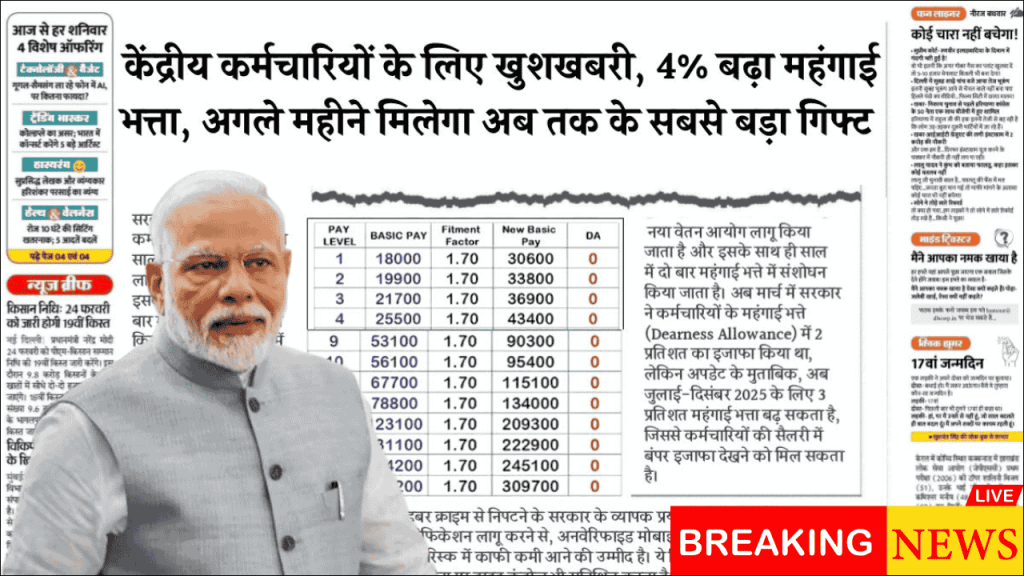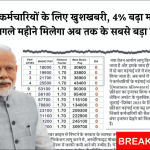
Bottom Line Up Front
Central government employees and pensioners are set to receive significant financial relief as the government prepares to announce a 3-4% increase in Dearness Allowance (DA), potentially raising it from the current 50% to 53-54%. This decision will benefit approximately 48 lakh central employees and 68 lakh pensioners, with implementation expected from July 2025.
Government’s Major Relief Initiative
The central government is preparing to deliver substantial financial relief to its workforce through a significant hike in Dearness Allowance. This announcement comes as a much-needed respite for millions of government employees and pensioners who have been grappling with rising inflation and increased cost of living.
The timing of this announcement is particularly significant as it coincides with the government’s bi-annual review process. This systematic approach ensures that employee compensation remains aligned with current economic conditions and inflation trends.
This DA hike represents one of the most substantial increases in recent years, demonstrating the government’s commitment to maintaining the purchasing power of its employees and pensioners in the face of economic challenges.
Understanding the DA Calculation Mechanism
The Dearness Allowance calculation is based on the All India Consumer Price Index for Industrial Workers (CPI-IW), which accurately reflects the impact of inflation on essential commodities and services. This scientific approach ensures fair and transparent adjustments.
Recent months have witnessed a notable increase in retail inflation rates, directly impacting the CPI-IW calculations. This rise in inflation has created the need for a corresponding adjustment in DA to maintain the real value of employee salaries.
The current DA rate stands at 50% of basic salary, and with the proposed 3-4% increase, it will rise to 53-54%. This adjustment follows the government’s established pattern of reviewing and revising DA twice annually in January and July.
Beneficiary Demographics and Impact
The proposed DA hike will create a massive positive impact across the central government workforce, reaching every corner of the employee and pensioner community.
Primary Beneficiaries:
- 48 lakh central government employees across various departments and ministries
- 68 lakh pensioners including retired government servants and their dependents
- Defence personnel and paramilitary forces
- Railway employees and postal service workers
- Employees of central public sector undertakings
The wide-reaching impact of this decision underscores the government’s comprehensive approach to employee welfare and its recognition of the diverse workforce that serves the nation.
Financial Impact Analysis
| Salary Component | Current Rate | After Hike | Monthly Benefit |
|---|---|---|---|
| Basic Salary | ₹30,000 | ₹30,000 | – |
| Current DA (50%) | ₹15,000 | – | – |
| New DA (53%) | – | ₹15,900 | ₹900 |
| New DA (54%) | – | ₹16,200 | ₹1,200 |
| Total Monthly Salary | ₹45,000 | ₹46,200 | ₹1,200 |
Detailed Salary Enhancement Examples
The financial benefits of the DA hike will vary based on individual salary levels, but every employee will experience meaningful improvement in their monthly income.
For Entry-Level Employees (₹20,000 basic salary):
- Current DA: ₹10,000 (50%)
- New DA: ₹10,800 (54%)
- Monthly increase: ₹800
For Mid-Level Employees (₹40,000 basic salary):
- Current DA: ₹20,000 (50%)
- New DA: ₹21,600 (54%)
- Monthly increase: ₹1,600
For Senior-Level Employees (₹60,000 basic salary):
- Current DA: ₹30,000 (50%)
- New DA: ₹32,400 (54%)
- Monthly increase: ₹2,400
These examples demonstrate how the DA hike creates proportional benefits across all salary levels while providing substantial relief to employees at every career stage.
Pension Enhancement Impact
Pensioners will experience equally significant benefits from the DA revision, as their Dearness Relief (DR) is calculated using the same methodology as employee DA.
Typical Pension Enhancement:
- Base pension: ₹15,000
- Current DR (50%): ₹7,500
- New DR (54%): ₹8,100
- Monthly increase: ₹600
This enhancement is particularly valuable for senior citizens who depend entirely on their pension income and face increased healthcare and living costs.
Implementation Timeline and Process
The government follows a structured timeline for DA implementation that ensures smooth transition and timely benefit delivery to all eligible recipients.
July 2025 Implementation Schedule:
- Official announcement expected in late June 2025
- Implementation from July 1, 2025
- First enhanced salary/pension payment in July 2025
- Arrears calculation for any retroactive periods
Administrative Process:
- Ministry of Finance coordination with all departments
- State government alignment for similar benefits
- Banking system updates for automated calculations
- Employee record verification and updates
Historical DA Trends and Context
Understanding the historical context of DA revisions helps appreciate the significance of the current hike and its impact on employee welfare.
Recent DA History:
- January 2024: 46% to 50% (4% increase)
- July 2023: 42% to 46% (4% increase)
- January 2023: 38% to 42% (4% increase)
- July 2022: 34% to 38% (4% increase)
This consistent pattern of substantial increases reflects the government’s proactive approach to maintaining employee purchasing power amid economic fluctuations.
8th Pay Commission Discussions
Alongside the DA hike announcement, discussions about the 8th Pay Commission have gained momentum within employee organizations and government circles.
Key Expectations for 8th Pay Commission:
- Implementation from January 2026
- Comprehensive salary structure revision
- Enhanced allowances and benefits
- Improved pension calculation methods
Employee unions are actively advocating for the early constitution of the 8th Pay Commission to address long-term compensation challenges and ensure government salaries remain competitive with private sector offerings.
Economic Rationale and Government Perspective
The DA hike decision reflects the government’s understanding of current economic realities and its commitment to employee welfare during challenging times.
Economic Justification:
- Rising fuel and food prices impacting household budgets
- Increased healthcare and education costs
- Housing and transportation expense inflation
- Need to maintain government employee motivation and productivity
Government Benefits:
- Enhanced employee satisfaction and retention
- Improved public service delivery quality
- Positive economic stimulus through increased consumer spending
- Demonstration of responsive governance
Broader Economic Implications
The DA hike will have significant ripple effects throughout the Indian economy, extending benefits beyond direct government employees.
Economic Multiplier Effects:
- Increased consumer spending in local markets
- Higher demand for goods and services
- Positive impact on retail and service sectors
- Enhanced economic activity in government employee-concentrated areas
Fiscal Considerations:
- Additional government expenditure of approximately ₹6,000-8,000 crores annually
- Balanced against economic stimulus benefits
- Long-term investment in human resource satisfaction
State Government Alignment
Historically, state governments follow central government DA decisions, extending similar benefits to their employees and creating nationwide impact.
Expected State Responses:
- Most states likely to implement similar DA hikes
- Timeline may vary based on individual state fiscal positions
- Additional beneficiaries: State government employees and teachers
- Combined impact: Over 1 crore employees and pensioners nationwide
Future Outlook and Expectations
The current DA hike sets a positive precedent for future employee welfare measures and demonstrates the government’s ongoing commitment to maintaining competitive compensation packages.
Anticipated Developments:
- Regular bi-annual DA reviews continuing
- Potential for additional increases if inflation persists
- Enhanced focus on other allowances and benefits
- Preparation for comprehensive pay commission implementation
Frequently Asked Questions
Q1: When will the new DA rate be implemented in salary accounts? The enhanced DA will be implemented from July 2025, with the first payment reflecting the increased rate expected in the July salary. Any arrears for the implementation month will be calculated and paid accordingly.
Q2: How is the DA percentage calculated and why does it vary? DA calculation is based on the All India Consumer Price Index for Industrial Workers (CPI-IW). The percentage represents how much additional allowance is needed to maintain purchasing power against inflation, which is why it changes every six months based on price movements.
Q3: Will state government employees also receive this DA hike? While state governments typically follow central government DA decisions, each state makes independent decisions based on their fiscal situation. Most states are expected to implement similar hikes, though timing may vary.
Q4: Does this DA hike affect other allowances and retirement benefits? Yes, since many allowances are calculated as a percentage of basic salary plus DA, this increase will enhance House Rent Allowance (HRA), Provident Fund contributions, and gratuity calculations. It also positively impacts pension calculations for future retirees.













